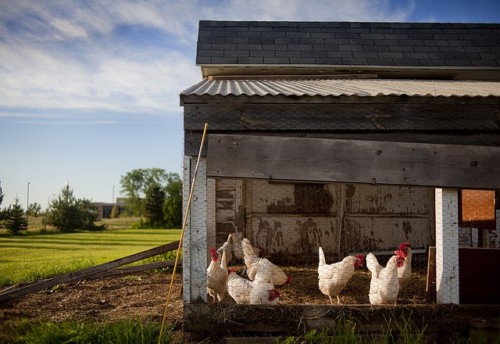Have you started raising chickens? Before you design or purchase a chicken coop for your birds, make sure to keep these crucial aspects in mind.
Do you require a stationary coop or a mobile tractor?
The sort of coop you select will depend on whether the hens will reside there full-time and have access to an outside run or bigger areas of pasture, or whether it has to be a mobile coop that can be moved about periodically to give the birds new foraging areas.
Decide as to whether your coop will be a permanent, stationary construction or whether you’ll require a mobile “chicken tractor” that you can move about as needed before you start any more planning.
What makes a good chicken coop?
Coop Size
The number of hens you plan to maintain, the kinds you’ll be keeping, and whether or not they have access to the outdoors will all affect the ideal chicken coop size.
If there is access to an outdoor run, it is typically advised that each chicken have two to four square feet of room within the chicken coop. At least two square feet of area are required for bantam breeds. Heavy breeds require a minimum of four.
Chickens of such size require at least three. The size requirements rise to five to ten square feet of room per bird if there is no outside access. Although the recommended minimum sizes are typically sufficient, it’s a nice idea to allow for more space if you can when picking a best chicken coop type.
Location
If you want to collect fresh eggs every day, it is better to keep the coop close to your house. However, some municipal rules require a specific distance between kennels for animals and homes, so be sure to check your local laws.
It’s incredibly useful to have electricity and water available at your chicken coop. Water is heavy to carry a long distance since chickens drink a lot of it.
A wooden chicken coop with an additional door is preferred.
The optimum location for a chicken coop is where there is room for an outside run.
Human access to chicken coops and storage
To clean, drink, feed, and generally take care of your chickens, you often have to go inside the chicken coops. It’s essential to have a workspace with easy access.
This means that a standing place within a chicken coop and a door that can be opened by a human are essential components to have. For smaller chicken coops, a movable roof that can be lowered to provide access to the inside for cleaning and poultry care is an excellent idea.
Plans for chicken coops occasionally exclude storage. A separate storage facility inside the structure would be a smart architectural solution, though. This is especially true if you don’t have any more barns or sheds.
Predator Defense
Many predators view chickens as a delicious meal, and they will use whatever means necessary to get them.
As a result, a coop with predator protection is an absolute necessity. It’s incredible how small a weasel can fit through a hole or how powerful and agile raccoons are. These common predators can quickly obliterate a flock if they gain entry to a chicken coop.
There shouldn’t be any coop openings that something could use to enter during the night. A 1/4 inch hardware cloth should be used to cover any windows or vents (even when open). Additionally, at night, the hens’ small pop-hatch door that they use to enter and depart the coop should shut tightly.
Ventilation
Chicken coops need to be properly ventilated all year round to eliminate the considerable levels of moisture, nitrogen, dust, and heat that hens create.
Effective ventilation also provides the air that chickens need to be healthy. The quantity and location of vents are required to change as the weather changes, so it’s essential to have a choice of ventilation options that can be closed or opened as needed.
Additionally, more vents are required when the number of chickens in the coops increases. Consider your coop’s ventilation requirements carefully. Inadequate ventilation can result in overheating, frostbite, eye problems, respiratory problems, and even death.
Cleaning
It should be simple to clean inside a chicken coop. It’s also crucial to provide some space for cleaning underneath the roosting area.
Particularly if the hens have access to grassland, the majority of the droppings collect there. Cleaning tasks can occasionally be facilitated by the use of removable trays or dropping boards, which are composed of robust chicken wire and allow droppings to fall to the ground.

The deep-litter strategy is popular among poultry caretakers, who let the bedding accumulate over several months. They then perform periodic thorough cleanings of the entire coop.
If you intend to employ this strategy, it is crucial to have tools available so that you can easily remove and replace all of the litter.
Nest boxes
Your chickens can lay their eggs in peace in nesting boxes, and you can find the eggs easily in time for breakfast.

Installing the nesting boxes lower and keeping them as darkened as possible can prevent birds from peeing in them.
There are different guidelines for nesting boxes for each bird, but 4-5 hens per box is a decent place to start. These boxes should be changed out on a regular basis to prevent the formation of dangerous germs.
Chickens love to nest and lay their eggs on soft bedding, but if they’re going to do either, they shouldn’t remain in the boxes for too long. There is no other use for the nesting box than egg-laying.
Roosts
For nighttime predator protection, chickens instinctively prefer to roost off the ground. They use smooth surfaces as roosts. Large roosts are helpful in the winter.
They allow backyard hens to spend the whole night keeping warm by tucking their feet under their feathers. The foot of two-by-fours should lay on the 4-inch width for ideal placement. The birds’ toes don’t stick out the sides since the boards are broad enough.
Plastic or metal pipe is inappropriate for roosts because backyard hens can’t grab it firmly enough. In the coop, each standard-size bird needs at least 8 inches of roosting space.
Lighting
Particularly if your hens will spend a lot of time inside the coop, adequate illumination is crucial. Your hens may cease laying eggs if there is little light since a chicken’s reproductive cycles are controlled by natural light.
The greatest approach to allowing natural light during the daytime is through windows. The Northern Hemisphere’s winter months, when there are fewer daylight hours, may be employed inside the coop with artificial lighting that is mild and yellow.
A constant light within the coop is not advised, though. Because artificial illumination can interfere with a chicken’s natural reproductive cycles, it should be utilized with caution.
Elevated Floor
Plywood is among the finest products for a chicken coop floor. To keep the floor and bedding dry, a plywood floor can be elevated off the ground. More rapidly than a concrete slab or a dirt floor, a floor with ventilation below will expel moisture.
Unwanted predators and rats cannot enter through a raised plywood floor because it is so tight. Use a tight wire mesh rather than wood to seal off the underside of the shed from intruders if your chicken coop is a storage shed with a plywood floor on runners.
The wire is preferable to wood since it keeps intruders out while yet allowing air to move beneath the shed.
What Is the Price of a Coop?
Because a DIY coop is made to your specifications and size, it’s hard to estimate the cost, but we’ve provided some samples below:
Online prices for basic, pre-built coops often start at $200 to $300 and go higher from there. On Craigslist, look for used coops or old sheds; if you’re patient, nice deals will present themselves since people move.
A building may frequently be used in new ways. Rather than beginning from scratch, remodel an existing shed, small barn, or doghouse.
It’s not always about trying to save money. Pre-made coops typically aren’t as strong or long-lasting as a coop you make yourself out of lumber.
Conclusion
A well-designed Backyard Chicken Coop will significantly improve your flock’s health and welfare and, over time, lower the cost of keeping hens.
On the other hand, raising hens in an old shed with a moist dirt floor and little ventilation may make it harder to maintain your flock healthy. It will also be simpler to clean a well-designed coop.
To be fully prepared for your chicken farming endeavor, pay close attention to the interior design and amenities of your new coop when buying.










